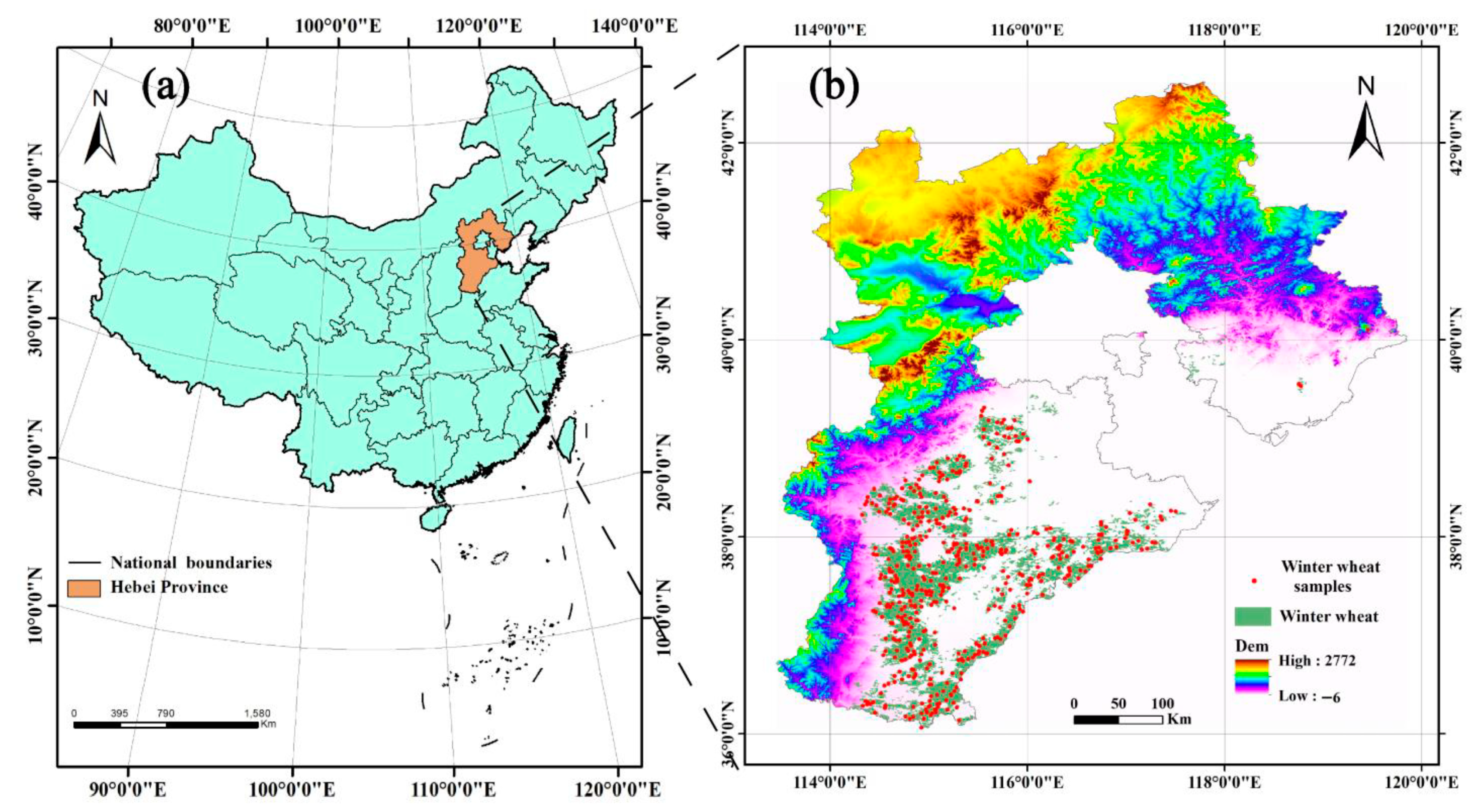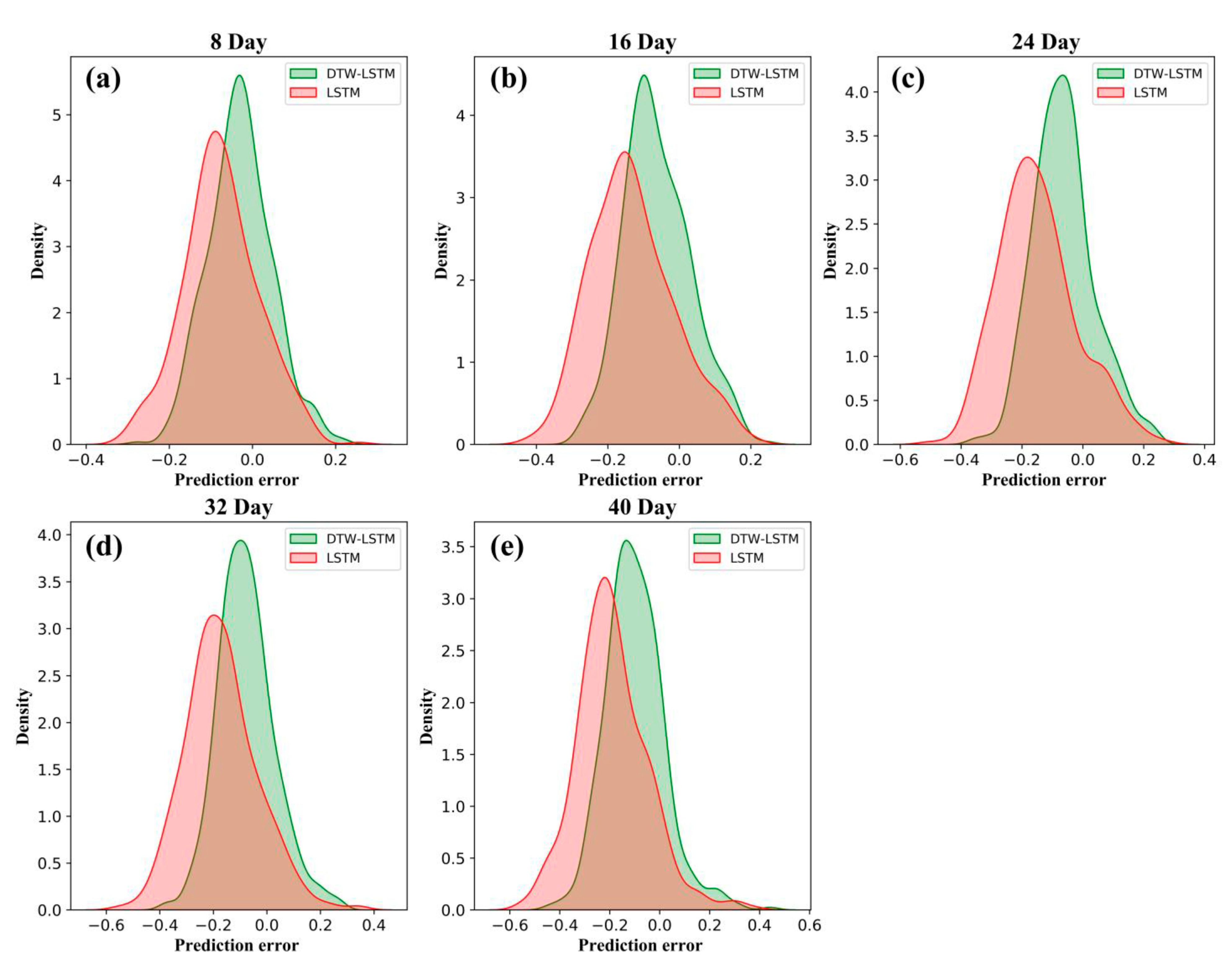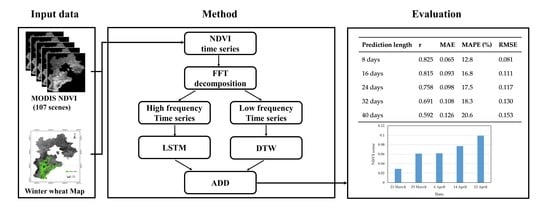Short and Medium-Term Prediction of Winter Wheat NDVI Based on the DTW–LSTM Combination Method and MODIS Time Series Data
Abstract
1. Introduction
2. Study Area and Data
2.1. Study Area
2.2. Data
2.2.1. Remote Sensing Data and Preprocessing
2.2.2. Winter Wheat Map
3. Methods
3.1. FFT Decomposition
3.2. DTW Model
- (1)
- Determine the two time -series A and B for which the DTW distance will be calculated.and . The length of the two time series is set to L.
- (2)
- Calculate the DTW distance between A and , denoted as . The specific method for DTW distance calculation is shown in Equations (2) and (3).
- (3)
- Find the time series . The DTW distance between and A has the minimum value.
- (4)
- The predicted value can be obtained by .
- (5)
- Bring as known data into the original winter wheat NDVI time series, and repeat steps (1) to (4).
| Algorithm 1 Time series prediction algorithm based on the DTW algorithm |
| Input: is the historical winter wheat NDVI time series. T represents the length of a complete winter wheat growth cycle. n represents the number of growth cycles. L represents length of the time series of the last incomplete cycle. Output: predict length is the length of the forecast. In this study, predict length is set to 5. for i = 0: predict length -1 do for j = 0: nT– L do The method of calculating DTW distance is shown in Equations (2) and (3). end for K = minindex(C) end for return |
3.3. LSTM Model
3.4. DTW–LSTM Combination Model
3.5. Prediction Accuracy Evaluation
4. Results
4.1. The Characteristics of Winter Wheat NDVI Time Series
4.2. FFT Decomposition Results
4.3. Prediction Accuracy and Analysis
5. Discussion
5.1. Comparison with the LSTM Method
5.2. Limitations and Future Perspectives
6. Conclusions
Author Contributions
Funding
Institutional Review Board Statement
Informed Consent Statement
Data Availability Statement
Acknowledgments
Conflicts of Interest
References
- Hatfield, J.L.; Gitelson, A.A.; Schepers, J.S.; Walthall, C.L. Application of spectral remote sensing for agronomic decisions. Agron. J. 2008, 100, S117–S131. [Google Scholar] [CrossRef]
- Berger, A.; Ettlin, G.; Quincke, C.; Rodriguez-Bocca, P. Predicting the Normalized Difference Vegetation Index (NDVI) by training a crop growth model with historical data. Comput. Electron. Agric. 2019, 161, 305–311. [Google Scholar] [CrossRef]
- Ahmad, R.; Yang, B.; Ettlin, G.; Berger, A.; Rodriguez-Bocca, P. A machine-learning based ConvLSTM architecture for NDVI forecasting. Int. Trans. Oper. Res. 2020, 12887. [Google Scholar] [CrossRef]
- Huang, J.; Han, D.W. Meta-analysis of influential factors on crop yield estimation by remote sensing. Int. J. Remote Sens. 2014, 35, 2267–2295. [Google Scholar] [CrossRef]
- Xue, J.R.; Su, B.F. Significant Remote Sensing Vegetation Indices: A Review of Developments and Applications. J. Sens. 2017, 2017, 1353691. [Google Scholar] [CrossRef]
- Yan, L.; Roy, D.P. Automated crop field extraction from multi-temporal Web Enabled Landsat Data. Remote Sens. Environ. 2014, 144, 42–64. [Google Scholar] [CrossRef]
- Estel, S.; Kuemmerle, T.; Alcantara, C.; Levers, C.; Prishchepov, A.; Hostert, P. Mapping farmland abandonment and recultivation across Europe using MODIS NDVI time series. Remote Sens. Environ. 2015, 163, 312–325. [Google Scholar] [CrossRef]
- Fernandes, J.L.; Ebecken, N.F.F.; Esquerdo, J.C.D. Sugarcane yield prediction in Brazil using NDVI time series and neural networks ensemble. Int. J. Remote Sens. 2017, 38, 4631–4644. [Google Scholar] [CrossRef]
- Cui, C.L.; Zhang, W.; Hong, Z.M.; Meng, L.K. Forecasting NDVI in multiple complex areas using neural network techniques combined feature engineering. Int. J. Digit. Earth 2020, 13, 1733–1749. [Google Scholar] [CrossRef]
- Ivits, E.; Cherlet, M.; Sommer, S.; Mehl, W. Addressing the complexity in non-linear evolution of vegetation phenological change with time-series of remote sensing images. Ecol. Indic. 2013, 26, 49–60. [Google Scholar] [CrossRef]
- Monday, M. Forecasting the Interannual Trends in Terrestrial Vegetation Dynamics Using Time Series Modelling Techniques. In ForestSAT Symposium Heriot Watt University; Heriot Watt University: Edinburgh, UK, 2002. [Google Scholar]
- Li, B.; Tao, S.; Dawson, R.W. Relations between AVHRR NDVI and ecoclimatic parameters in China. Int. J. Remote Sens. 2002, 23, 989–999. [Google Scholar] [CrossRef]
- Ji, L.; Peters, A.J. A spatial regression procedure for evaluating the relationship between AVHRR-NDVI and climate in the northern Great Plains. Int. J. Remote Sens. 2004, 25, 297–311. [Google Scholar] [CrossRef]
- Propastin, P.A.; Kappas, M. Reducing uncertainty in modeling the NDVI-precipitation relationship: A comparative study using global and local regression techniques. Gisci. Remote Sens. 2008, 45, 47–67. [Google Scholar] [CrossRef]
- Fernandez-Manso, A.; Quintano, C.; Fernandez-Manso, O. Forecast of NDVI in coniferous areas using temporal ARIMA analysis and climatic data at a regional scale. Int. J. Remote Sens. 2011, 32, 1595–1617. [Google Scholar] [CrossRef]
- Yue, L.W.; Shen, H.F.; Zhang, L.P.; Zheng, X.W.; Zhang, F.; Yuan, Q.Q. High-quality seamless DEM generation blending SRTM-1, ASTER GDEM v2 and ICESat/GLAS observations. ISPRS J. Photogramm. 2017, 123, 20–34. [Google Scholar] [CrossRef]
- Zang, L.; Mao, F.Y.; Guo, J.P.; Wang, W.; Pan, Z.X.; Shen, H.F.; Zhu, B.; Wang, Z.M. Estimation of spatiotemporal PM1.0 distributions in China by combining PM2.5 observations with satellite aerosol optical depth. Sci. Total Environ. 2019, 658, 1256–1264. [Google Scholar] [CrossRef]
- Atkinson, P.M.; Tatnall, A.R.L. Introduction Neural networks in remote sensing. Int. J. Remote Sens. 1997, 18, 699–709. [Google Scholar] [CrossRef]
- Mas, J.F.; Flores, J.J. The application of artificial neural networks to the analysis of remotely sensed data. Int. J. Remote Sens. 2008, 29, 617–663. [Google Scholar] [CrossRef]
- Kang, L.; Di, L.; Deng, M.; Yu, E.; Xu, Y. Forecasting vegetation index based on vegetation-meteorological factor interactions with artificial neural network. In Proceedings of the 2016 5th International Conference on Agro-Geoinformatics (Agro-Geoinformatics), Tianjin, China, 18–20 July 2016. [Google Scholar]
- Nay, J.; Burchfield, E.; Gilligan, J. A machine-learning approach to forecasting remotely sensed vegetation health. Int. J. Remote Sens. 2018, 39, 1800–1816. [Google Scholar] [CrossRef]
- Stepchenko, A.; Chizhov, J. NDVI Short-Term Forecasting Using Recurrent Neural Networks. Environ. Technol. Resour. Proc. Int. Sci. Pract. Conf. 2015, 3, 180. [Google Scholar] [CrossRef][Green Version]
- Reddy, D.S.; Prasad, P.R.C. Prediction of vegetation dynamics using NDVI time series data and LSTM. Modeling Earth Syst. 2018, 4, 409–419. [Google Scholar] [CrossRef]
- Wu, T.S.; Fu, H.P.; Feng, F.; Bai, H.M. A new approach to predict normalized difference vegetation index using time-delay neural network in the arid and semi-arid grassland. Int. J. Remote Sens. 2019, 40, 9050–9063. [Google Scholar] [CrossRef]
- Sakoe, H.; Chiba, S. Dynamic Programming Algorithm Optimization for Spoken Word Recognition. IEEE Trans. Acoust. Speech Signal Process. 1978, 26, 43–49. [Google Scholar] [CrossRef]
- Petitjean, F.; Inglada, J.; Gancarski, P. Satellite Image Time Series Analysis Under Time Warping. IEEE Trans. Geosci. Remote 2012, 50, 3081–3095. [Google Scholar] [CrossRef]
- Petitjean, F.; Weber, J. Efficient Satellite Image Time Series Analysis Under Time Warping. IEEE Geosci. Remote Sens. 2014, 11, 1143–1147. [Google Scholar] [CrossRef]
- Costa, W.S.; Fonseca, L.M.G.; Korting, T.S.; Bendini, H.D.; de Souza, R.C.M. Spatio-Temporal Segmentation Applied to Optical Remote Sensing Image Time Series. IEEE Geosci. Remote Sens. 2018, 15, 1299–1303. [Google Scholar] [CrossRef]
- Xue, Z.H.; Du, P.J.; Feng, L. Phenology-Driven Land Cover Classification and Trend Analysis Based on Long-term Remote Sensing Image Series. IEEE J. Sel. Top. Appl. Earth Obs. Remote Sens. 2014, 7, 1142–1156. [Google Scholar] [CrossRef]
- Maus, V.; Camara, G.; Cartaxo, R.; Sanchez, A.; Ramos, F.M.; de Queiroz, G.R. A Time-Weighted Dynamic Time Warping Method for Land-Use and Land-Cover Mapping. IEEE J. Sel. Top. Appl. Earth Obs. Remote Sens. 2016, 9, 3729–3739. [Google Scholar] [CrossRef]
- Xiao, C.J.; Chen, N.C.; Hu, C.L.; Wang, K.; Gong, J.Y.; Chen, Z.Q. Short and mid-term sea surface temperature prediction using time-series satellite data and LSTM-AdaBoost combination approach. Remote Sens. Environ. 2019, 233, 111358. [Google Scholar] [CrossRef]
- Cooley, J.W.; Tukey, J.W. An Algorithm for the Machine Calculation of Complex Fourier Series. Math. Comput. 1965, 19, 297–301. [Google Scholar] [CrossRef]
- Loyarte, M.M.G.; Menenti, M.; Diblasi, A.M. Modelling bioclimate by means of Fourier analysis of NOAA-AVHRR NDVI time series in Western Argentina. Int. J. Climatol. 2008, 28, 1175–1188. [Google Scholar] [CrossRef]
- Srivastava, S.; Dikshit, O. Seasonal and trend analysis of TWS for the Indo-Gangetic plain using GRACE data. Geocarto Int. 2020, 35, 1343–1359. [Google Scholar] [CrossRef]
- Kocaaslan, S.; Musaoglu, N.; Karamzadeh, S. Evaluating Drought Events by Time-Frequency Analysis: A Case Study in Aegean Region of Turkey. IEEE Access 2021, 9, 125032–125041. [Google Scholar] [CrossRef]
- Gorelick, N.; Hancher, M.; Dixon, M.; Ilyushchenko, S.; Thau, D.; Moore, R. Google Earth Engine: Planetary-scale geospatial analysis for everyone. Remote Sens. Environ. 2017, 202, 18–27. [Google Scholar] [CrossRef]
- Zhao, F.; Yang, G.J.; Yang, X.D.; Cen, H.Y.; Zhu, Y.H.; Han, S.Y.; Yang, H.; He, Y.; Zhao, C.J. Determination of Key Phenological Phases of Winter Wheat Based on the Time-Weighted Dynamic Time Warping Algorithm and MODIS Time-Series Data. Remote Sens. 2021, 13, 1836. [Google Scholar] [CrossRef]
- Gan, L.Q.; Cao, X.; Chen, X.H.; Dong, Q.; Cui, X.H.; Chen, J. Comparison of MODIS-based vegetation indices and methods for winter wheat green-up date detection in Huanghuai region of China. Agric. For. Meteorol. 2020, 288, 108019. [Google Scholar] [CrossRef]
- Marquezino, F.L.; Portugal, R.; Sasse, F.D. Obtaining the Quantum Fourier Transform from the classical FFT with QR decomposition. J. Comput. Appl. Math. 2010, 235, 74–81. [Google Scholar] [CrossRef]
- Zhang, Y.L.; Gao, Y.; Jiang, P.S.; Xu, H.Y. Study of Polyphase Decomposition Zoom-FFT Algorithm in Non-Invasive Motor Monitoring System. In Advanced Materials Research; Trans Tech Publications Ltd.: Freienbach, Switzerland, 2011; pp. 1452–1457. [Google Scholar]
- Ahamed, S.F.; Rao, G.S.; Ganesh, L. Fast Acquisition of GPS Signal Using FFT Decomposition. Procedia Comput. Sci. 2016, 87, 190–197. [Google Scholar] [CrossRef]
- Hochreiter, S.; Schmidhuber, J. Long Short-Term Memory. Neural Comput. 1997, 9, 1735–1780. [Google Scholar] [CrossRef]
- Wang, J.Y.; Li, J.Z.; Wang, X.X.; Wang, J.; Huang, M. Air quality prediction using CT-LSTM. Neural Comput. Appl. 2021, 33, 4779–4792. [Google Scholar] [CrossRef]
- Dehnad, K. Density Estimation for Statistics and Data Analysis. Technometrics 2012, 29, 495. [Google Scholar] [CrossRef]











| Parameter | Value |
|---|---|
| Time_step | 20 |
| Rnn_unit | 30 |
| Batch_size | 30 |
| Input_size | 1 |
| Output_size | 1 |
| Learning_rate | 0.0006 |
| Predict_num | 5 |
| Prediction Length | r | MAE | MAPE (%) | RMSE |
|---|---|---|---|---|
| 8 days | 0.825 | 0.065 | 12.8 | 0.081 |
| 16 days | 0.815 | 0.093 | 16.8 | 0.111 |
| 24 days | 0.758 | 0.098 | 17.5 | 0.117 |
| 32 days | 0.691 | 0.108 | 18.3 | 0.130 |
| 40 days | 0.592 | 0.126 | 20.6 | 0.153 |
Publisher’s Note: MDPI stays neutral with regard to jurisdictional claims in published maps and institutional affiliations. |
© 2021 by the authors. Licensee MDPI, Basel, Switzerland. This article is an open access article distributed under the terms and conditions of the Creative Commons Attribution (CC BY) license (https://creativecommons.org/licenses/by/4.0/).
Share and Cite
Zhao, F.; Yang, G.; Yang, H.; Zhu, Y.; Meng, Y.; Han, S.; Bu, X. Short and Medium-Term Prediction of Winter Wheat NDVI Based on the DTW–LSTM Combination Method and MODIS Time Series Data. Remote Sens. 2021, 13, 4660. https://doi.org/10.3390/rs13224660
Zhao F, Yang G, Yang H, Zhu Y, Meng Y, Han S, Bu X. Short and Medium-Term Prediction of Winter Wheat NDVI Based on the DTW–LSTM Combination Method and MODIS Time Series Data. Remote Sensing. 2021; 13(22):4660. https://doi.org/10.3390/rs13224660
Chicago/Turabian StyleZhao, Fa, Guijun Yang, Hao Yang, Yaohui Zhu, Yang Meng, Shaoyu Han, and Xinlei Bu. 2021. "Short and Medium-Term Prediction of Winter Wheat NDVI Based on the DTW–LSTM Combination Method and MODIS Time Series Data" Remote Sensing 13, no. 22: 4660. https://doi.org/10.3390/rs13224660
APA StyleZhao, F., Yang, G., Yang, H., Zhu, Y., Meng, Y., Han, S., & Bu, X. (2021). Short and Medium-Term Prediction of Winter Wheat NDVI Based on the DTW–LSTM Combination Method and MODIS Time Series Data. Remote Sensing, 13(22), 4660. https://doi.org/10.3390/rs13224660








